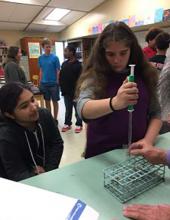
While microplastics are small and often invisible to the naked eye, their impact on marine ecosystems is tremendous. Microplastics can enter the ocean as small particles like microbeads in cosmetics and fibers from polyester clothing, or they can be formed through photodegradation of larger plastics like bottles, bags, straws, or cigarette butts. Microplastics are often mistaken by marine life for food, and they often contain or carry on their surface chemicals that are harmful to animals that accidentially eat the plastics. Scientists are only beginning to understand the extent of the microplastics problem and what species are being affected.
About these educational resources
This series of field and classroom-based experiments enables middle school students to explore the problem of microplastics. These hands-on activities have been conducted with school groups with guidance and materials from university scientists in North Carolina.
- Microplastics: Beach Walk Activity - In this activity, students sift sand and examine the small pieces of plastic hiding in their beach sand.
- Microplastics: Plastic Tow Activity - In this activity, students learn how a plankton net can be used to collect and study microplastics in the water.
- Worksheet: Calculating Impervious Surface - In this activity, students use a satellite aerial image to calculate the amount of impervious surface.
- Worksheet: Journey of a Raindrop - In this activity, students imagine the adventures of a rain drop as it moves through the water cycle.
- Microplastics: Anemone Feeding Experiment - In this activity, students conduct an experiment and observe the behavior of the anemone that is offered several different types of plastic.
- Plastic vs. Natural Substrate: Marine Biofouling Experiments - In this activity, students observe how different marine animals colonize on natural and plastic material that is placed in coastal waters for four weeks.
- Marine Debris Toxicity Worksheet 1: Predictions & Methods - This worksheet helps students develop predictions and prepare their materials to conduct an experiment about the toxicity of leachate from marine debris
- Marine Debris Toxicity Worksheet 2: Experiment - Students can use this worksheet to conduct an experiment to measure the toxicity of leachate from marine debris on barnacle larvae.
How these were developed
These activities were developed through a partnership involving scientist and graduate students participating in a Science Collaborative research project that assess storm water impacts in coastal North Carolina. Guidance and support was provided by Duke University Marine Lab Community Science Initiative Water Quality Program and the North Carolina Scientific Research and Education Network.
For additional information or to request support or training on these lessons, visit: Duke University Marine Lab Community Science Initiative Water Quality Program.